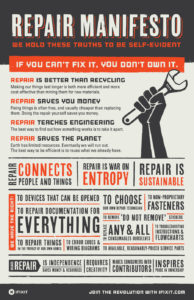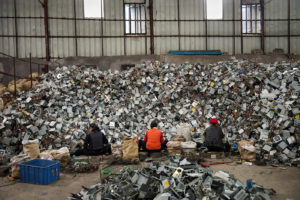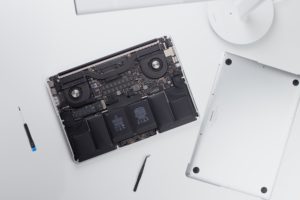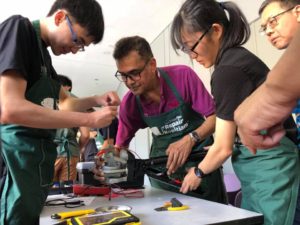Published 3 February 2020 ● Last Updated on 9 August 2023
It all began with my computer screen just randomly starting to flicker. First, it was for a few seconds, then it became minutes and now I needed to shut it down for a few hours to resolve the problem. That is when I learnt about Flickergate, a problem unique to the Microsoft Surface Pro 4. Anyhow, I called the company to check how this could be resolved, (and no surprise?!) they have no solution other than offering customers to purchase a brand new screen at a discounted rate. I checked if they had any repair option and of course there wasn’t. Plus, if I try to get it repaired, the company will not be held responsible for any damage!
Now this got me thinking, what on earth happened to good old repairing and reusing things? Right through the 90s (and even early 2000s), most of our electronic goods came with manuals that enabled customers to fix stuff ourselves. And if we couldn’t do it, there were enough repair shops that would offer this service. However, the art of repairing seems to be dying! Be it personal items like clothes, shoes and handbags or household goods like furniture and upholstery or even electronic goods like phones, cameras and laptops, nowadays the trend is to ‘use and throw’ instead of the more eco friendly option of ‘repair and reuse’. My frustration at not being able to do much about my ‘dancing screen’ and searching for repair options led me to discover the Right to Repair Movement (and later compile a listing of repair service providers in Singapore).

What does right to repair mean?
It’s a simple enough idea – Each one of us should be able to exercise our right to choose to repair and reuse an old item.
Now, this could be looked at from two perspectives: one of the consumer and the other of the manufacturer. When we talk of the consumers’ perspective, it means how conscious we are of reducing our own waste and ensuring that we make the most of the products that we own. Just because the stitching of a piece of clothing has come off, doesn’t mean that it’s time to get rid of it – let’s take a needle and thread and repair it! Similarly, shoes and handbags can also be given a new lease of life by good repair work. But all this is possible when we move from the ‘use and throw’ mindset to a ‘repair and reuse’ one!
When it comes to electronic goods, the manufacturers’ perspective plays a very important role. Earlier, most goods came with manuals that allowed ‘skilled’ consumers repair their own stuff or you could get it fixed at any repair shop at a very reasonable cost. Today, the manufacturer wants to make more profits and so they hold the monopoly on repair – if you wish to repair something, you can do it only with an authorised dealer and at a cost that is sometimes higher that buying a brand new item! This is one of the main reasons why repairing of items has reduced and, therefore, global waste production has increased.

The importance of Repair and Reuse
It is estimated that the world generates around 50 million tonnes of e-waste annually! (Singapore generates 60,000 tonnes of e-waste or nearly 70 mobile phones per person annually.) Of this, only 20% is recycled. And if nothing is done about this now, research shows that this could become 120 million tonnes by 2050.
When it comes to personal items – clothes, shoes and accessories, the fact we live in a world of ‘fast fashion’ just adds to the problem. It is estimated that in the last 15 years, while production of garments has doubled the duration of their usage has fallen by 40%. A recent study points out that nearly 85% of the global textile waste could actually have been recycled!
All in all, the take-make-waste mindset needs to be replaced by the repair and reuse mindset to encourage circularity and eventually sustainability. Choosing to repair our goods will be one of the many solutions to ensure that we can reduce our waste considerably.
The Right to Repair Movement
The term right to repair refers to the legal concept that allows consumers to repair the products they buy or choose with their own service providers instead of going through the manufacturer.
Currently, any law or legislation with regard to the Right to Repair movement exists predominantly in the US and European Union. It may be a while before this movement becomes a global one.
One of the earliest bills that brought this cause into focus was the Motor Vehicles Owners Right To Repair Act that was passed in the state of Massachusetts in 2012 and became a law in 2013. The aim of this was to make the automobile manufacturers provide the necessary information for anyone to repair the vehicles, thereby ending their monopoly on repairs. The major auto trade organisations signed a memorandum agreeing to meet all the requirements and applying this to all 50 states of the US starting 2018. More recently, this act is up for review now as new wireless technologies seem to threaten the owners right to be able to repair their vehicles at a place of their choice.
Inspired by the success in the field of automobiles, The Repair Association was founded in 2013 to apply the same principles of repair to electronics in the US and they have been leading the battle against big companies to get owners their right to fix their goods on their own or at a place of their choice.
Across the Atlantic Ocean, the European Union passed legislation in 2019 – starting 2021, firms will have to make longer lasting appliances as well as supply spare parts for the same up to 10 years. This rule is applicable to lighting, washing machines, dishwashers and refrigerators; all home appliances that seem to conk off the minute the warranty is over!

Consumer v/s Manufacturers: Prominent Case Studies
American company John Deere has made it difficult for farmers to repair their own tractors thanks to the newly installed software protected by the Digital Millennium Copyright Act. So, the farmers found a way around it and started buying 40-year-old tractor models as they could be repaired locally without having to go to an expensive authorised dealer.
Another company that is opposing the right to repair laws vehemently is tech giant, Apple Inc. According to them, allowing people to repair their own iPhones could lead to substandard repair, making consumers vulnerable to hackers which could even be dangerous! Apple wants to have a monopoly on repairing their products because they earn around $1billion to $2billion by only fixing iPhones!
In 2018, Samsung and Apple were both fined €5 million each in Italy for slowing down older versions of their mobile devices using software upgrades. Apple was fined an additional €5 million for not providing the appropriate information that allowed customers to change their batteries.

Is R2R a global phenomenon?
While it may take a few more years to become a global phenomenon, R2R is definitely spreading out.
In 2019, Australia agreed to consider making laws that allowed people to repair their phones and other electronic goods instead of just dumping them. New Zealand does have Consumers Guarantee Act in place, but it has a loophole when it comes to providing spare parts for repair of a de-funked appliance. However, they are hoping to fix these loopholes to ensure lesser products end up in landfills without having lived a full long life.
The repair landscape in Singapore
Now, Singapore has laid down a Lemon Law where a consumer can make a claim for a defective product sold to him or her within 6 months of purchase. However, it clearly mentions that if the consumer had tried to repair the item himself or had someone else try to repair it, and in the process damaged it, there will be no solutions provided.
While the Lemon law is applicable to a wide range of general products from electronics to automobiles to apparel, it is Murphy’s Law that everything gets spoiled the minute the stipulated time period of repair or a warranty is over!
Starting January 2020, the NEA is planning on introducing an Extended Producer Responsibility (EPR) approach to ensure that e-waste disposal is done in a regulated manner. It will be the producers responsibility to collect and dispose of specified goods in the correct manner as well as ensure that parts that can be reused will be removed and recycled. Also, retailers will have to offer customers one to one take back on the regulated consumer products as well as have in store collection bins for e-waste.
Notwithstanding the law and the soon to be introduced ERP, there are some good fixers (and eco minded souls) around Singapore who help repair things and give them an extended life. So where do you start?
1. Pledge to start supporting the global repair movement NOW, here.
2. Follow our Where to Repair in Singapore guide.
Related Articles:
Declutter, Donate, Dispose: Our guide to giving away old things in Singapore
DrabToFab | Broken, abandoned tray table becomes a bright addition to the living room



0 Comments